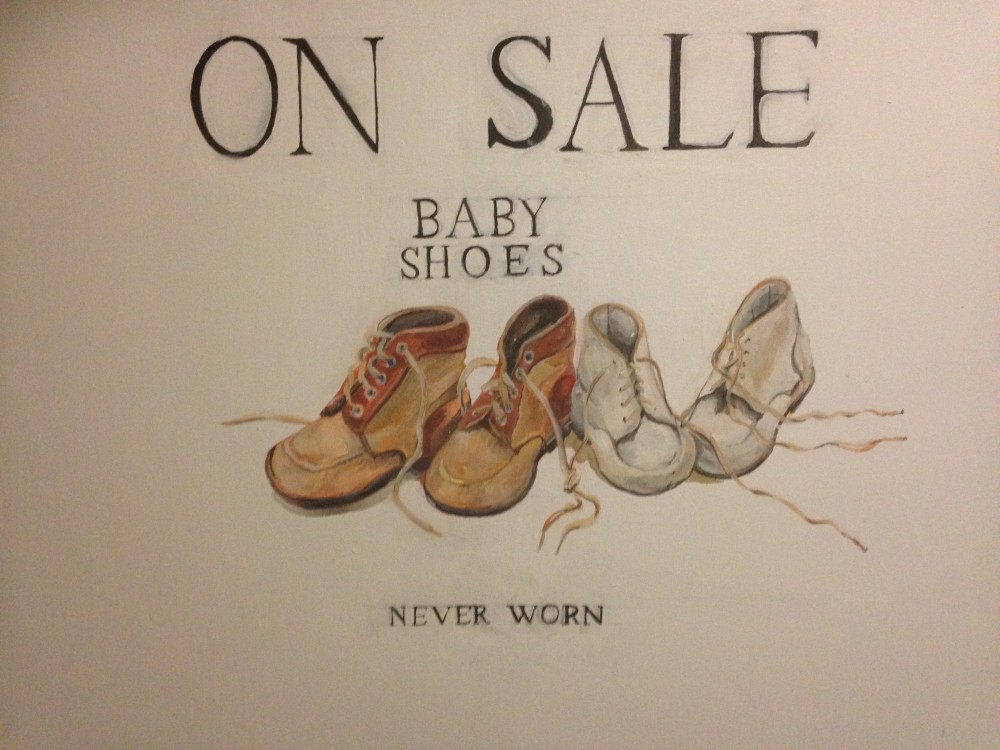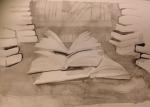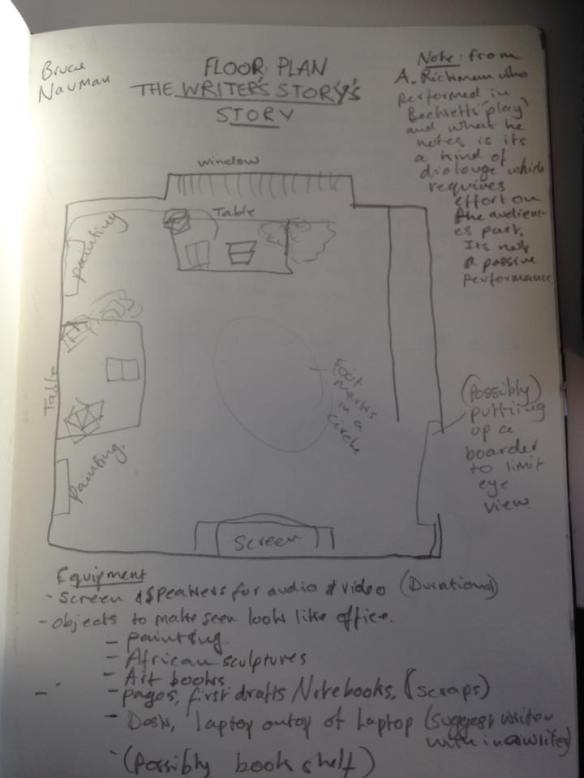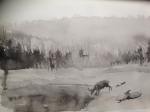On the advice of my studio tutor. I have been reading Samuel Beckett plays for inspiration and to get an idea about creating short films. Beckett was ideal in many regards, first because his plays range from two hours long to as brief as 8 minutes, but in all his work he asks profound questions about existential crises, politics, philosophy and uses delightful dark humour. What I admired about his work the most was his amazing ability of using just language to create intense feelings in the audience which is part of what I want to bring to my own scripts.
I’ve written one short story called the Imitation games (although I may change the title); which is about a girl named Rachel with Autism, the story first tells incidences from her childhood to show how her mind works and the pressure she feels from not fitting with others. She then takes part in a Turing test and is mistaken for a computer. Wanting to improve her social skills, she speaks to the computer in an effort to see how it is programmed to appear to human. The story is designed to ask questions about what is this quality in humans which separates us from machines, and such a trait restricted to only a few in society.
The script Paul, was a a response to Beckett’s play “Waiting for Godot.” I liked how the characters dialogue consisted of quick exchanges which while very plain or simple, could be interpreted as political and philosophical questions. The story is set in a graveyard where the two characters have presumably just been to a funeral. The one character Jack is terribly depressed and discusses with his friend Paul who has terrible memory why their lives seem so apparently sad and what legacy they could hope to leave behind after they die. With the use of humour, the story brings to the surface sad beliefs about the apparent meaninglessness of life.
I also rewrote “Writer’s story’s story” into a script format with scenes and character actions described in the text.
I also did two speed drawings for my current project on miners life and in preparation for filming “Writer’s story’s story.”
imitation-game-version-3 paul the-writer-script-version
Of Beckett’s plays I’ve looked at so far, I have read:
Krapp’s last tape, which is like a dialogue between an old man and his younger self with no actual exchange between them, just listening to a tape. Ohio Impromptu, two characters supposedly the same man playing the reader of a letter and the listener – splitting a single character into two very different roles. I played with this concept last year myself, when I did a performance with a video recording I made in which I have a conversation with it.
Waiting for Godot, a tale of two men (possibly hermits) wait by a tree waiting for a man called Godot and instead meet Ponzo and Lucky and a message boy. A lot of the story is not explained in detail; such as who Godot is, why some characters can’t remember anything from the previous scene or why these men are waiting for Godot in the first place. I like the writing very much, because of how well written it is; incorporating humorous, ideas of faith, belief, philosophy and ethics and the language used has a strong emotional impact on the viewer.The structure of the script inspired my own short script “Paul”, I liked how the dialogues of “Waiting for Godot” would used quick exchanges between characters and drift on and off the main topic.
Not I, a monologue performance of a mouth uttering jumbled words; telling the story of a woman of seventy who was abandoned after a premature birth, living a loveless, mechanical existence, and he suffered an unspecified traumatic experience. The performance on stage or on screen is terrifically intense, disturbing and powerful performance as all the action and drama is concentrated just on the words and the mouth. I played with the use of just the mouth last year in a set of video’s, which similar to Beckett tell the story of a character’s horrible isolation and fall from grace.
Ohio Impromptu, who the two characters are in this short play is not known. My own favorite interpretation, is that the characters (the listener and the reader) are two parts of a single psyche/mind, and the interaction between them as the reader reads is how a personal feels reading a sad story (Most likely their own), and they feel the need to stop every now and again as they read this tale, or reread it passages just because it is so emotional.
Catastrophe, a play set on a theatre stage where a director and his assistant and trying to organize the last scene of a play (called Catastrophe) where only the protagonist is present – with no lines, he simply follows the direction of the director whilst his assistant takes notes of additional features to add. The play has been interpreted by some as an allegory for totalitarian rein and the fact that the director (Symbol of the dictator) is creating a catastrophe with the protagonist (representing the dictator’s people.)
Breath, this play is interesting as not only is it Beckett’s shortest play (As long as 50 seconds) with no words, actors only the sound of an inhale and exhale, whilst the stage is littered with rubbish (but no vertical shapes). This piece works better as an installation then it does as an actual play.
Play, a one act play where three large grey identical urns are sited next to one another. Protruding out of the top of the urns are three stock characters. In the middle urn is a man (M). To his right is his wife (W1) or long-time partner. The third urn holds his mistress (W2). The Urns speak and tell their own tale in regards to the other two. The main part of this play is made up of short, occasionally fragmented sentences spoken in a rapid tempo like a chorus. This play inspired a short script I wrote “Black Swans”, which uses similar devices such as the character’s don’t refer to always if ever communicate to one another but to the audience, the topic being discussed quickly alternates and the identity of the characters isn’t revealed. They only refer to each other as “He” or “She.”
Come and Go, a brief play consisting of three characters Flo, Vi, and Ru, who all attended Miss Wade’s School. They sit quietly, in which one speaks at a time and each get up allowing the other two to converse about the other; to which the one speaking shocks the listener with a secret the audience do not hear, although some have suggested they each our ill from a terminal disease and are hiding the secret from one another. The three are also reminiscent of the three witches from Macbeth. They all hold hands as they once did, but the suggestion is they no longer have the same intimacy as before.
Rough for Theatre I, a play set with two charcaters. A blindman who plays out of tune a violin – in the hopes of being given money from passers by. He is lost and cannot find his bearings, he meets a man in a wheel chair with one leg finds. The second man suggests they team up, and that he could be the first character’s eyes while he pushes the other’s chair. Theoretically a reasonable plan and the blind man can ask his new acquintance to describe the world around him, as he can no longer even tell if it is day or not. Because the other man can see what things are really like he holds a bleaker vision of what the future has in store. Up until hearing the sound of music he has hardly ventured out and not traveled far at that. Although he has offered to be the fiddler’s eyes he becomes annoyed when continually asked to describe how things are and when he tells him that it’s “day” he feels the need to add an “if you like” casting a shadow of doubt on even this simple answer. The two become frustrated with one another and the man in the chair asks the blind man why he does not just kill himself, to which the blind man says simply he’s “not unhappy enough yet.”
Rough for Theatre II, this short story plays on the idea that a person’s life cannot easily be reduced into documented evidence and proof; through two bureaucrats who discuss amounts themselves “person C’s” (who stands in front of an open window as if ready to jump) life. The two sit together getting quite tense with one another as to whether the man should indeed jump and how wasteful his life has been.
Act without words I, a performance with out words. A man is shown in a desert dying of thirst and he is almost flaunted with hovering objects like a bottle of water – which raises out of his reach, or a box which is too small for him to stand ontop and grab the water. Driven in deep frustration, he attempts to kill himself from a tree with a rope, two boxes and then with a pair of scissors to cut his wrists, but the objects fly away. Giving up entirely on ever quenching his thirst, he ignores the bottle of water when it floats in front of him. As a performance, it’s a very clever story shown, albeit without the strong languange that Beckett is famous for. I may consider writing a piece like this and employing animation to make the film.
Act without words II, like “Act without words I,” “II” does not rely on words to tell it’s story, but on a mime performance of two men walking across the stage. One who that takes pride in his appearance while the other doesn’t. Each wakes out of a sack after being prodded, puts on a pair of garments and indulges either in eating, sorting their out fit out and the picking up another large bag (Holding the other character) and his own, and carries it to a different part of the stage. They then take of the clothes, get back into the sack as if it were a sleeping bag and the poking instrument wakes the other character who repeats the same behavior as the previous one with a different attitude. The piece seems to be a reflection on the daily routines of every life; waking, dressing, cleaning, eating, working and then going back to sleep, like a repetitive cycle which just goes on and on, with no real sense of end. The fact that each one is carrying the other, could be an analogy of unison among people in society and a dependence (and that people can either be happy or unhappy in the same situation), or it may represent how people work for one another, doing tasks they find laborious and often unpleasant without for a moment wondering if there’s much point in their activity.
End game, set in an aftermath of an apocalyptic disaster. All who survive is an elderly blind man who can not stand or walk, named Hamm. He treats all who live with him in his house such as his parents (Nagg and Nell) who sleep in dustbins because they have no legs and Clov (Hamm’s servent who is unable to sit and was supposedly given to Hamm to be looked after by Clov’s father). The play revolves around the characters telling old stories to one another (albeit no one wanting to listen) and looking out at the world through the window to see every thing is gone and they are slowly running out of supplies. Hamm is eventually left all on his own, with his parents dead and Clov gone (Who often complains and wants to escape Hamm.)















